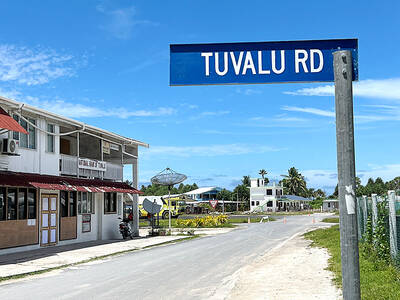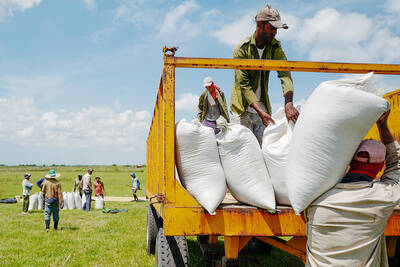Large areas of southern China have been hit by the worst storms and floods in decades, the government said yesterday, as warnings emerged that the Yellow River in the north could also wreak havoc for millions.
China’s far-southern industrial hub braced for floods that have killed 169 across the region, adding to the toll of natural disasters that have pummeled the country this year.
Officials in Guangdong Province warned of a “black June” as high tides, rain and two converging swollen rivers threatened levees, Xinhua news agency said.
Heavy rains in the past 10 days have forced the evacuation of 1.66 million people in the south, the Ministry of Civil Affairs said. Direct economic losses totaled nearly US$2.2 billion.
The death toll covered the period since the flood season began at the beginning of the summer.
Guangdong expects possible flooding in the low-lying Pearl River Delta, which embraces several big export manufacturing zones, including Foshan, Zhongshan and the provincial capital, Guangzhou.
RECEDING WATER
In the suburbs of the delta city of Dongguan, one of the Pearl River’s many tributaries remained swollen, but residents said the muddy-brown water had dropped significantly.
A 64-year-old farmer, who gave only his surname, Liang, was tending to a small patch of yams on the banks of the river.
“The water came up to here,” Liang said, pointing at a spot on the levee about 3m to 4m above the water level. “It washed away all my cabbages.”
The typhoon season has begun, making further disaster likely for the coast of Guangdong, home to 110 million permanent and migrant residents.
“The Pearl River Delta river network has suffered not only the biggest volume floods in over 50 years but simultaneously also the highest tides in over 10 years,” a report on the Guangdong water resources office Web site said.
Rarely a year goes by when China does not suffer floods, drought and other natural disasters somewhere on its huge landmass.
Fierce snow storms blanketed much of the south in January and the country is reeling from the May 12 quake centered in Sichuan Province that killed more than 70,000.
Parts of the quake zone and other provinces have also been battered by heavy rains, floods and landslide risks as Beijing prepares to host the Olympics in August.
In Wenchuan County, site of the quake epicenter, troops were rushing to move close to 20,000 people threatened by landslides as heavy rains approached, Xinhua reported. More than 52,000 had already moved out of threatened areas, the report said.
Flooding has struck as far north as Longnan, on the southern tip of Gansu Province, north of Sichuan, where 365 died and 1.8 million were left homeless after the May 12 quake.
Roads and highways in Guangdong have suffered damage amounting to about US$86 million, Xinhua reported.
MORE DOWNPOURS
The National Meteorological Center forecast more downpours for nine provinces — including the already battered Guangdong, Guangxi, Hunan and Jiangxi — across south and east China in the next two days, warning of floods, lightning and landslides.
“We must remain clear-headed and not underestimate the serious nature of the current flood and disaster situation,” Vice Premier Hui Liangyu (回良玉) said in comments posted on the Web site of the state flood prevention headquarters.
“We have to limit the loss of life and property to the lowest extent possible,” Hui said. “We cannot underestimate the arduous nature of fighting the flooding and warding off disaster.”
Rains were expected to continue in the region this week.
In the north, the government urged the strengthening of dikes and reservoirs along the Yellow River.
“National flood prevention and relief efforts are entering a crucial phase,” the flood headquarters said in a statement. “According to the water and meteorological departments, we could be seeing torrential rains and flooding along the Yellow River.”

FORUM: The Solomon Islands’ move to bar Taiwan, the US and others from the Pacific Islands Forum has sparked criticism that Beijing’s influence was behind the decision Tuvaluan Prime Minister Feletei Teo said his country might pull out of the region’s top political meeting next month, after host nation Solomon Islands moved to block all external partners — including China, the US and Taiwan — from attending. The Pacific Islands Forum (PIF) leaders’ meeting is to be held in Honiara in September. On Thursday last week, Solomon Islands Prime Minister Jeremiah Manele told parliament that no dialogue partners would be invited to the annual gathering. Countries outside the Pacific, known as “dialogue partners,” have attended the forum since 1989, to work with Pacific leaders and contribute to discussions around

END OF AN ERA: The vote brings the curtain down on 20 years of socialist rule, which began in 2005 when Evo Morales, an indigenous coca farmer, was elected president A center-right senator and a right-wing former president are to advance to a run-off for Bolivia’s presidency after the first round of elections on Sunday, marking the end of two decades of leftist rule, preliminary official results showed. Bolivian Senator Rodrigo Paz was the surprise front-runner, with 32.15 percent of the vote cast in an election dominated by a deep economic crisis, results published by the electoral commission showed. He was followed by former Bolivian president Jorge “Tuto” Quiroga in second with 26.87 percent, according to results based on 92 percent of votes cast. Millionaire businessman Samuel Doria Medina, who had been tipped

Outside Havana, a combine belonging to a private Vietnamese company is harvesting rice, directly farming Cuban land — in a first — to help address acute food shortages in the country. The Cuban government has granted Agri VAM, a subsidiary of Vietnam’s Fujinuco Group, 1,000 hectares of arable land in Los Palacios, 118km west of the capital. Vietnam has advised Cuba on rice cultivation in the past, but this is the first time a private firm has done the farming itself. The government approved the move after a 52 percent plunge in overall agricultural production between 2018 and 2023, according to data

ELECTION DISTRACTION? When attention shifted away from the fight against the militants to politics, losses and setbacks in the battlefield increased, an analyst said Recent clashes in Somalia’s semi-autonomous Jubaland region are alarming experts, exposing cracks in the country’s federal system and creating an opening for militant group al-Shabaab to gain ground. Following years of conflict, Somalia is a loose federation of five semi-autonomous member states — Puntland, Jubaland, Galmudug, Hirshabelle and South West — that maintain often fractious relations with the central government in the capital, Mogadishu. However, ahead of elections next year, Somalia has sought to assert control over its member states, which security analysts said has created gaps for al-Shabaab infiltration. Last week, two Somalian soldiers were killed in clashes between pro-government forces and